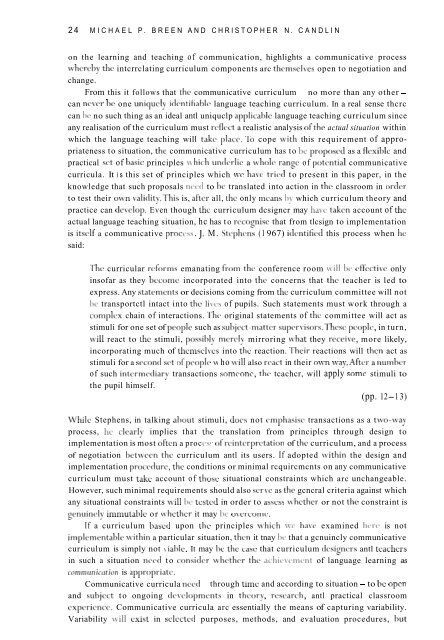Download - Search
Download - Search
Download - Search
Create successful ePaper yourself
Turn your PDF publications into a flip-book with our unique Google optimized e-Paper software.
24 MICHAEL P. BREEN AND CHRISTOPHER N. CANDLINon the learning and teaching of communication, highlights a communicative processwhereby the intcrrclating curriculum components arc themselves open to negotiation andchange.From this it follows that the communicative curriculum no more than any other -can ncvcr bc one uniquelp itlcntifialde language teaching curriculum. In a real sense thcrccan lie no such thing as an ideal antl uniquclp applicablc language teaching curriculum sinceany realisation of the curriculum must rctlcct a realistic analysis ofthe actual situation withinwhich the language teaching will take place. 'lh cope cvith this requirement of appropriatenessto situation, thc communicative curriculum has to be proposcd as a flcxihlc andpractical set of hasic principles 1% hich underlie a \vholc range of potential communicativecurricula. It is this set of principles which \vc have tried to present in this paper, in theknowledge that such proposals need to Iic translated into action in thc classroom in ortlcrto test their obvn valitlity.This is, after all, the only means by which curriculum theory andpractice can develop. Even though thc curriculum dcsigncr may haw takcn account of theactual language teaching situation, hc has to rccognise that from tlcsign to implementationis itsclf a communicative proc . J. M. Stephens (1967) idcntificd this process when hesaid:The curricular rcforms emanating from the conference room \vi11 be cffcctive onlyinsofar as they become incorporated into the concerns that the teacher is led toexpress. Any statcmcnts or decisions coming from thc curriculum committee will notlie transportctl intact into the li of pupils. Such statements must work through acomplex chain of interactions. 'l'he original statements of the committee will act asstimuli for one set of pcoplc such as sulijcct-matter super\-isors.Thcse pcoplc, in turn,\vi11 react to the stimuli, possililp mcrclp mirroring \vhat they rcceive, more likely,incorporating much of themselves into thc reaction. Their reactions will then act asstimuli for a second sct ofp~oplc \z ho cvill also rcact in their mz-n way. After a numberof such intermctliary transactions somconc, thc tcachcr, will apply some stimuli tothe pupil himself.(pp. 12-13)While Stephens, in talking about stimuli, docs not cmphasisc transactions as a t\vo-\vayprocess, he clcarlp implies that the translation from principlcs through design toimplementation is most oftcn a proc ' ofi-cintcrprctation of the curriculum, and a processof negotiation lietcvccn the curriculum antl its users. If adopted lcithin the design andimplementation procedure, the conditions or minimal rcquircmcnts on any communicativecurriculum must take account of those situational constraints which arc unchangeable.However, such minimal requirements should also serve as the gcncral criteria against whichany situational constraints \vi11 lie tcstctl in order to assess lvhcthcr or not the constraint isgenuincly immutal)lc or lvhcthcr it may I>c ovt~rconit~.If a curriculum Inscd upon the principles \vhich \vc havc examined here is notimplementalilc \Tithin a particular situation, then it tnay lie that a gcnuincly communicativecurriculum is simply not ialdc. It may Iic the caw that curriculum dc-signers antl teachersin such a situation nccd to consider lvhcthcr thc achicv,mcnt of language learning ascommunicution is appropi-iate.Communicative curricula ncctl through timc and according to situation - to lie openand suhjcct to ongoing developments in theory, research, antl practical classroomexperience. Communicative curricula arc essentially the means of capturing variability.Variability \vi11 exist in selected purposes, methods, and evaluation procedures, hut


